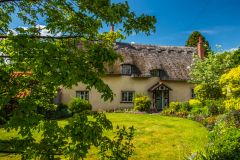
Polstead is a quintessential Suffolk village, a place of timeless peace, of fascinating history, of beautiful thatched cottages and a historic manor house, and of a 7th-century saint.
St Cedd
The saint was Cedd, who came here in AD 653 to convert the natives to Christianity. Cedd (AD 620-664) was an Anglo-Saxon monk from Northumbria, sent by King Oswiu to convert the East Saxon kingdoms in what is now East Anglia. He founded numerous churches. including the famous Saxon chapel at Bradwell-on-Sea in Essex.
Sometime during Cedd's mission, traditionally in the year AD 653, he came to Polstead to preach to the pagan populace. He preached by an oak tree, which later became known as the Gospel Oak. The tree, in the grounds of Polstead Hall, can be viewed from the churchyard. The tree finally fell down in 1953, and an analysis of the tree-rings showed that it was over 1400 years old.
It is quite likely that the tree was already a place of some veneration before Cedd came to Polstead. Today a descendant of the original Gospel Oak grows from the remains of the ancient tree.

Given the sacred nature of the Gospel Oak, it is no surprise that the parish church of St Mary was built beside it. The church is an early 12th-century building with 14th and 15th-century additions. Stones from a Roman villa are incorporated into the church walls, and the Norman arches are made with the earliest English bricks n existence, fired around 1160. Look for the touching memorial to Jacob Brand, lord of the manor of Polstead, shown laying his hand on the head of his dead son Benjamin.
From the churchyard you can get good views of Polstead Hall, a 16th-century manor house standing n a former deer park. The house was enlarged in the late 18th century and given a facelift in 1818 by William Pilkington, a successful London architect. The Hall facade is centred on an Italianate porch supported on Tuscan columns. The Hall is in private hands and is not usually open to visitors.
The name Polstead means place by the pool. In this case, there are two pools, one very large, set in the valley bottom. On one side a hill rises up to Polstead Hall and the church, on the other side the rather aptly named Polstead Hill road rises steeply up to the north-east. Both sides of the lane are lined with beautiful timber-framed and thatched cottages.

At the top of the hill is a small green, and beside it the village hall, Cock Inn pub and the community-run village shop and post office. The Cock Inn is a traditional 17th century coaching inn. There is another pub at Bower House Tye, just to the north.
Technically Polstead is made of five separate hamlets; Whitesetreet Green, Polstead Heath, Polstead Green, Polstead Hill, and Mill Street. Not surprisingly, it is one of the largest parishes in Suffolk.

The Red Barn Murder
Exploring Polstead today it is hard to imagine that in 1827 it was the scene of a tragic murder that gripped 19th-century society. Even today the tragic events are not fully known, but it appears that a pair of young lovers, Maria Marten and William Corder arranged to meet at the Red Barn, a local landmark on Barnfield Hill, and elope to Ipswich. Maria was never seen again, but Corder sent her family letters saying that she was in good health. Her body was discovered buried in a grain storage bin in the barn.
Corder was found in London, where he had already started a new family He was tried for Maria's murder, convicted, and hanged in Bury St Edmunds. Polstead became a tourist destination and souvenir hunter's chipped pieces from Maria's gravestone until it had disappeared. They also stripped the barn bare, and enterprising businessmen turned wall planks into toothpicks for sale. Mementoes from the case, including a death mask of Corder's head later used by phrenology enthusiasts, are on display at Moyses Hall Museum in Bury St Edmund.
Reminders of the infamous murder can still be found. Martens Lane runs south-east, away from the village ponds, and on the lane is Maria Martens Cottage, a 17th-century timber-framed house under a thatched roof.
Polstead is one of the most picturesque villages in England. I've visited several times and thoroughly enjoy myself each time I return.
About Polstead, Suffolk
Address: Polstead,
Suffolk,
England
Attraction Type: Village
Location: On minor roads three miles south-west of Hadleigh. The nearest postcode is CO6 5AH.
Website: Polstead, Suffolk
Location map
OS: TL991381
Photo Credit: David Ross and Britain Express
HERITAGE
 We've 'tagged' this attraction information to help you find related historic attractions and learn more about major time periods mentioned.
We've 'tagged' this attraction information to help you find related historic attractions and learn more about major time periods mentioned.
Find other attractions tagged with:
NEARBY HISTORIC ATTRACTIONS
Heritage Rated from 1- 5 (low to exceptional) on historic interest
Polstead, St Mary's Church - 0.2 miles (Historic Church) ![]()
Stoke-by-Nayland, St Mary's Church - 1.2 miles (Historic Church) ![]()
Thorington Hall - 2.2 miles (Historic Building) ![]()
Boxford, St Mary's Church - 2.3 miles (Historic Church) ![]()
Groton, St Bartholomew's Church - 2.9 miles (Historic Church) ![]()
Boxted, St Peter's Church - 3.1 miles (Historic Church) ![]()
Higham, Suffolk, St Mary's Church - 3.2 miles (Historic Church) ![]()
Kersey, St Mary's Church - 3.6 miles (Historic Church) ![]()












